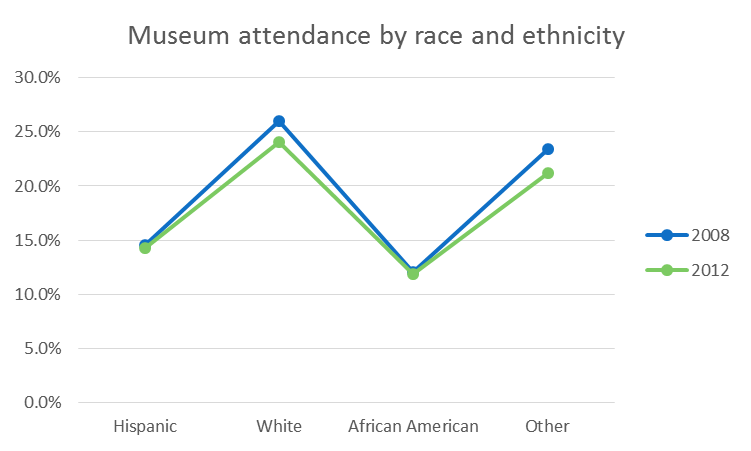Despite the best efforts of organizations nationwide, the NEA’s 2013 report – How a Nation Engages with Art shows that since 2002 art museum attendance has been on a steady decline. In 2012, only 21% of adults said they attended an art museum over the past year, down 5.5% from 2002. The graphs below – excerpted from the NEA report – show that attendance has decreased in almost all of the measured categories. Some of the largest drops in attendance came from individuals aged 18-44. In fact, the only age segmentations to grow in 2012 were individuals 65 years and older. This population may have the means to be exceptional donors, however they probably will not keep attendance numbers growing 10 to 20 years in the future. Institutional survival may be a struggle unless museums can show audiences their relevance and encourage active participation.




Something needs to change if museums desire to transition from being an institution about something to an institution for somebody. Arts managers know that younger people learn and interact with the world differently. Yet, they are slow to change habits or think outside of standard practices. This is only one cohort example and museums need to adapt and find new methods to engage community members of all segmentations. Audiences no longer accept the traditional paradigm of being talked at by a museum curator; they want to participate, and feel connected to the museum and objects. Intelligently integrated technology can achieve these desires for participation and connectedness while also reaching audiences like never before. The Cleveland Museum of Art’s Gallery One initiative, is an exceptional example.
The Cleveland Museum of Art Gallery One and ArtLens App
Cleveland Museum of Art’s Gallery One and ArtLens mobile app have been a topic of interest for the AMT Lab team over the past year. Contributors have written several posts, including ARTLENS @ Gallery One: A Look At The Future Of Museum Engagement and Interweaving Social: An Interview With The Cleveland Museum Of Art's Reena Goodwin, Part 1. Why? Because the technology integrated across the CMA is thoughtful, in-depth, and enriches the experience of museum goers who want to participate. It is a beautiful example of how museums can transcend a static experience and explore new limits of learning and engagement.
Gallery One opened in 2013 after the completion of extensive museum renovations and expansion. The planning process involved almost every department within the organization and extensive support from external collaborators. Gallery One includes the following interactive features:
- ArtLens: A mobile application for iPad, iPhone and Android that guides visitors through the permanent collection at the museum or at home.
- Collection Wall: The largest, multi-touch wall in the U.S. featuring over 4,100 pieces in the permanent collection in 32 curated views. Museum goers can collect artwork on iPads and phones to create a personalized tour through the museum collection.
- Interactives: Six touchscreens with a thematic activity for participants to discover art through kinesthetic or entertaining activities.
- Studio Play: Combines technology and tactile activities for young visitors and families to discover works in the permanent collection together.
Introducing Gallery One: a unique blend of art, technology, and interpretation. Come experience art in a whole new way. Come see amazing.
These technological endeavors range in depth and educational value, which may be controversial for some museum administrators. However, they do something very successfully: open the door to audiences without feeling like an afterthought or an impediment to the traditional museum experience. The technology enables a more informal and social environment, lowering the barrier of entry to some audiences and providing deeper educational value for others. And finally, initiatives such as the ones described at the CMA may be a step toward turning around those negative museum attendance trends.
What do you think? Can technology embraced by museums really build audiences and reverse these negative attendance trends?
In my next blog post I will highlight WolfBrown’s audience typologies as a framework for how the CMA is able to more effectively reach diverse learners through Gallery One and ArtLens.


